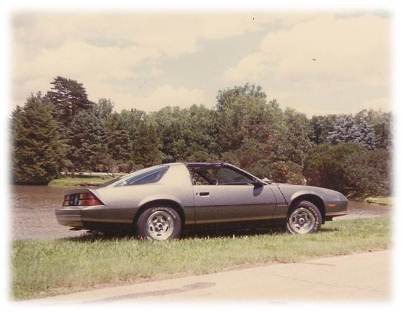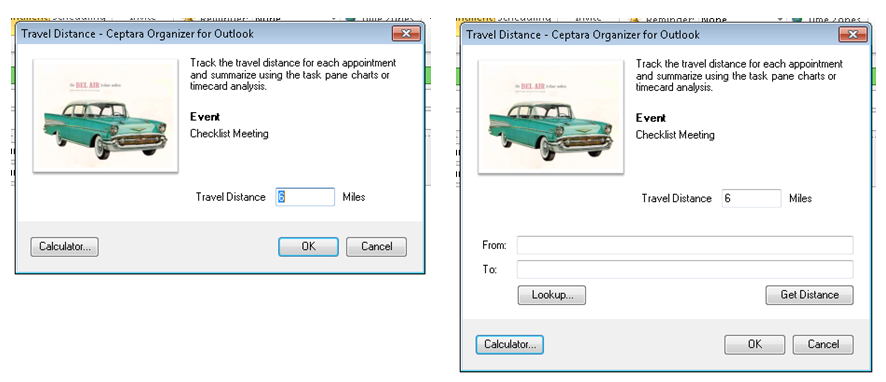Mileage Tracking in Microsoft Outlook
Problem
In 1987, at the University of Nebraska, my engineering career had its beginning. As a celebration of that moment (and after I had gotten a job - which is important), I bought my first new car, a 1987 Chevrolet Camaro Sport Coupe. Perhaps because I just graduated from engineering school, I kept a mileage log, carefully recording every mile each time I filled up with gas. And then I got married, had two kids. Guess what happened to the Camaro when the first child came into our lives? Life got busy, and the mileage log was left behind.
As the Founder and CEO of Ceptara, I find myself traveling frequently. Often for sales calls and in some cases for consulting projects. The need to track mileage has once again presented itself. I considered going back to the mileage log book that had so faithfully served me in my formitive years, however, because we use our own tools in tracking time, it made sense to see how the [Organizer] tool could support mileage tracking.
Outlook Supports Mileage Tracking
Microsoft Outlook's Appointment object contains a mileage property, however, it doesn't seem to be presented in the Outlook user interface. Good news, we didn't need to add a user property to track the distance traveled, all that was needed was to create the user interface to manage the field.
The Organizer tracks distance in either miles or kilometers (set via the Options dialog), and presents the information via the Mileage Pie Chart in the Task Pane or through the Timecard function. You can record the distance traveled using the ‘Mileage’ button on an appointment.

Microsoft Outlook Appointment, Mileage Ribbon Button
A dialog is presented after the Mileage button is selected to enter the distance, or a distance calculator can be optionally displayed to assess the distance between two addresses (the MapQuest service is used to find the distance). Simply press the Calculator button to expand the dialog.
Mileage Dialog | Mileage Dialog showing Distance Calculator
You can manually type in the “From” and “To” addresses into their respective fields or use the Lookup button to retrieve an address from a contact in your default contacts list. To lookup the address, put the cursor in the “From” or “To” text box and then select the Lookup button. Whichever field was selected will be populated with the Lookup selection. If your contact has multiple addresses, the field will provide the option of selecting a specific address.
If the Outlook Appointment “Location” field is populated, the Travel Distance dialog will copy the information into the “To” field to save some typing.
For example, if I’m traveling from my office to a client, I would enter my office address in the “From” field. I would then place my cursor in the “To” field and then press the Lookup button. Once I’ve found my client in the default contacts list, one or more addresses will be returned. If there is one address, then the “To” field will reflect that address. If there are multiple addresses, the “To” field will be changed to a drop down list, and I can pick the specific address that I’m traveling to.
In the United States, the address should be in the form; [Street Address], [City], [State], e.g. 16825 48th Ave. W, Lynnwood, WA. Once the addresses are entered, press the ‘Get Distance’ button to populate the Travel Distance text box and press OK to save the information.
If the Appointment “Location” is empty, the Travel Distance dialog will return the “To” address and populate that field.
Reporting
In addition to marking off time on my calendar when I'm executing a task, or spending time with a client, I'll record the travel time before and after an appointment. In the 'Travel' appointments, I record the mileage to and from the appointment. Or if I have a number of appointments during the day in different parts of the city, I'll record 'Travel' appointments between each meeting along with the distance traveled to each appointment. When it comes time to do our time reporting, I can use the Organizer Task Pane's Mileage Pie Chart to show me how many miles I've driven for a given period of time.
The example below shows the miles traveled for the period of October 22nd to October 26th. In Outlook's Calendar view, I can select the dates in the To-Do bar, and then select the Mileage Pie Chart from the Organizer Task Pane.
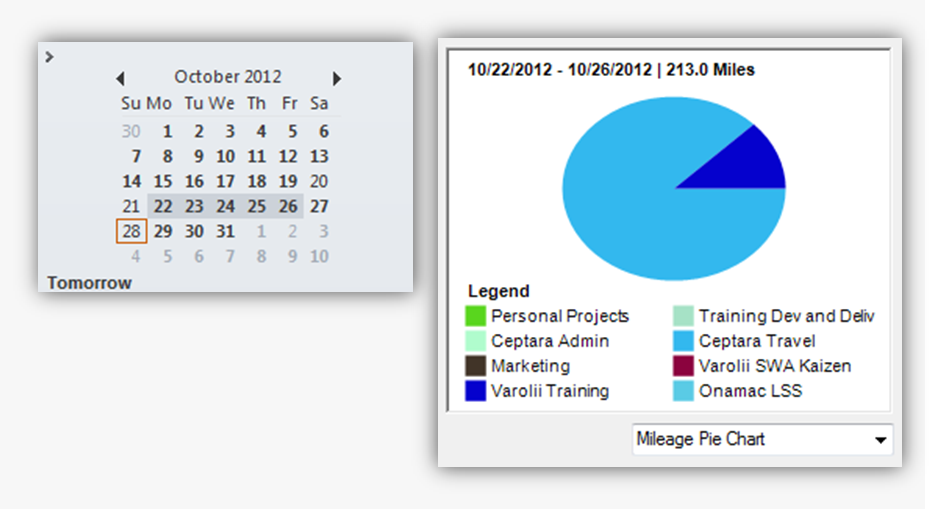
Organizer Task Pane, Mileage Pie Chart
If you need to analyze the distance traveled more specifically, the Timecard tool (on the Organizer Task Pane's menu bar) can export a list of appointments for a given time period using the 'Records File' format. The exported file can be opened in Microsoft Excel, each appointment (row) contains columns for the time spent in the appointment and any mileage that was recorded. A pivot table or chart can be created to analyze the exported information. For example:
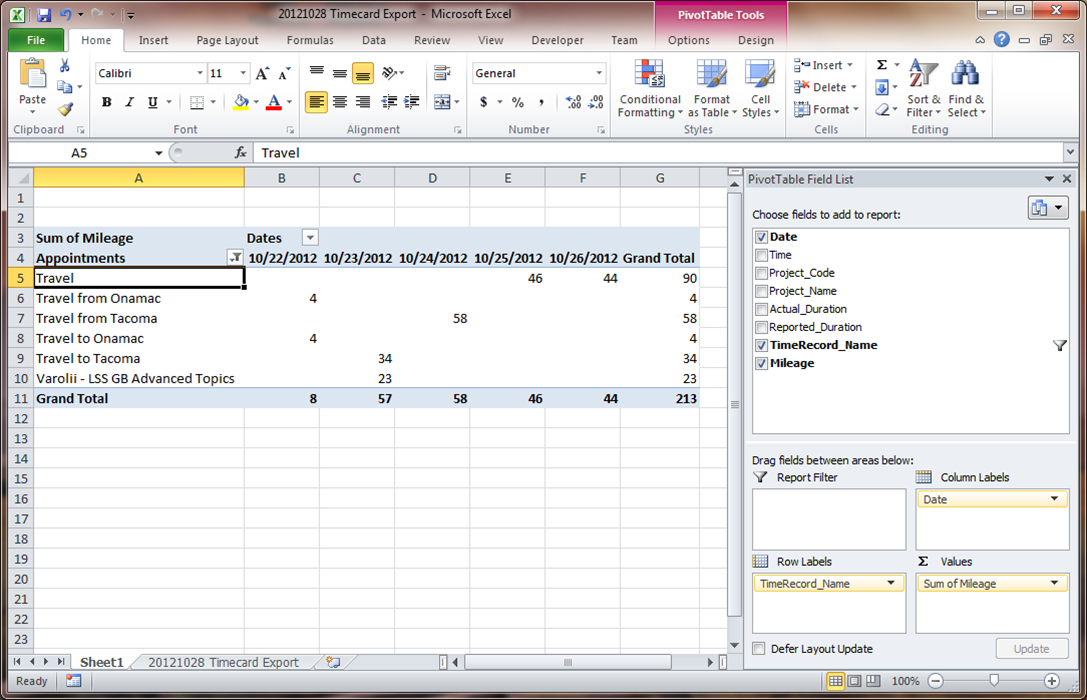
Timecard Export, Travel Distance Analysis
Conclusion
Microsoft Outlook is one of our main tools - I spend much of time in the application. Since we had a need to track the time we spend working on deliverables and in client meetings, the Organizer add-in has a very good tool for analyzing time. Extending the time tracking tool to include travel distances was a natural extension of its capabilities and served as an additional and important function in how we manage our business.
Before you go out and purchase a mileage log for everyone in your organization who needs to track their travel distances, I hope you give our tool a try - if your shop uses Outlook as much as we do, I'm sure you'll find the tool very useful.
- Chris's blog
- Login or register to post comments
-

 Printer-friendly version
Printer-friendly version Post to Twitter
Post to Twitter- Send by email
- PDF version
Recent Updates
Microsoft Outlook Add-In
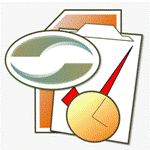
Focus on Your Life, Not Your Inbox
Achieve greater focus by shifting your attention from e-mail to accomplishing what matters most!
Company News
Stay up to date with our newsletter!



